Teachers’ Toolkits
Nine teachers share their tips for helping themselves, their students, and their families cope during coronavirus
We asked nine teachers from across the state what they’ve discovered as they’ve navigated the school closure and what it means to their teaching practice and their students. Here’s what they said:

Giovanna Papa, Washington County
This has been a new adventure for me in terms of strictly teaching online. I have found many resources helpful in assisting with achieving quality instruction to be presented to my students.
My absolute favorite resource I have used is the SeeSaw app. This app allows students to annotate, type, insert images, etc onto the template I upload. This work can also be uploaded to a class feed where students can give each other feedback! I have quickly learned that this online teaching platform is conducive to absorbing you 24/7, so I have also quickly learned to set a time to close my laptop each day.
The best thing that I have done to clear my mind everyday is to go outside to take a walk in my neighborhood and get some fresh air! It has to be a balance.
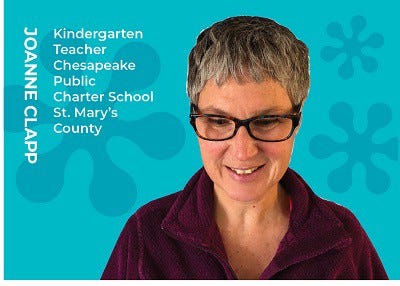
Joanne Clapp, St. Mary’s County
Teaching kindergarten online is definitely a challenge! As we know early childhood learning is best done hands-on but that is not an option at this time. Our school system has chosen to use Imagination Learning Language and Literacy and Imagine Learning Math as the platform to continue our students’ academic instruction.
To support these lessons I like to film myself doing games and activities that we would do in the classroom. I like to feel that these “windows” into the classroom offer a little feeling of normalcy to my little community. These games and activities also give the families a chance to share in the learning process while spending time together.

Bryan Trueblood, Prince George’s County
Google Classroom has been a great tool for me to maintain open lines of communication with students to ensure they are remaining active during this time away from school. I’ve learned that my county currently offers private YouTube accounts for educators to interact with students and their families.
I’ve been working on creating workout regimens that parents and students can perform in their homes using body weight or basic household items as resistance during training. I’ve even started challenges so students and parents can compete — Daily Step Tracking, 10 x 10 Challenge: 10 exercises, 10 reps, 10 days (not including weekends!). Incorporating parents into the workout allows families to bond with their children on a different level. It also allows parents to appreciate the hard work the students have been putting in for the school year.
A suggestion I offer to readers and their families is to identify a specific location within their home for working out. Before going to bed, take your phone to the exercise location and allow it to charge there overnight. This will work as a motivator to do a small amount of training before you start the day and possibly before you call it a night.
Remember: it’s never too late to start treating yourself to a physically fit lifestyle and any amount of effort is better than none. If you need more support or would like to participate in my challenges, feel free to find me on Instagram @btrue_story.

Kelly Garrison, Baltimore County
The past few weeks began a new adventure for many of us — an adventure my school district is calling the “Continuity of Learning Plan.” I will admit I was quite nervous about this adventure. However, I have been pleased with the amount of support I’ve received through professional development and the overwhelming support of my co-workers and grade-level team. One of my favorite things has been using Google Meets to connect with my students and their families.
My best piece of advice for educators is to focus on the positive and embrace the unique opportunities of virtual learning.

Kentavius Jones, Dorchester County
A great online resource to help students build their reading skills is Vocabulary.com. Students are taught use context and prior knowledge to determine the meaning of words. It’s interactive and the students love the competition component.
This time away from the classroom and my students has given me a new appreciation for my work and my relationships with the kids. I miss them daily and dearly. I advise students and parents to get outside and exercise as much as possible. Experiencing nature and exerting energy is great for the mind and body.
I encourage parents to reach out teachers if they need help assisting their children with school work. We are here to help! Stay home and stay safe!
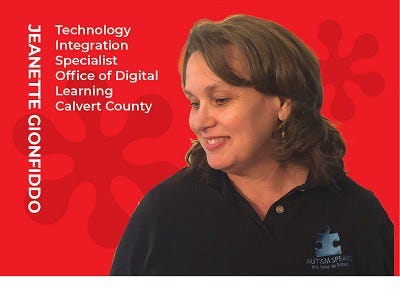
Jeanette Gionfriddo, Calvert County
I’m a technology Integration specialist. My team at the office of digital learning is here to support staff and families move into online home learning. My tip to teachers is to reach out to your tech support if you find yourself struggling with a new tool or program. We are here to help.
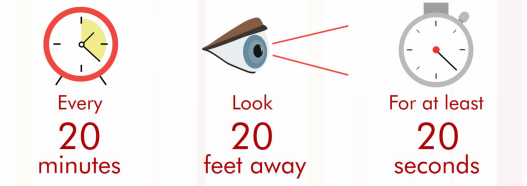
When the technology seems to be stressing you out, step away and take a break. MSDE and the Maryland Department of Health have a 20–20–20 rule: every 20 minutes, look at an object 20 feet away and stare at it for 20 seconds. This will rest both your eyes and your mind. We can do this!

Celeste Jordan, Carroll County
Two things have struck me as the most difficult. First is not seeing my students’ faces. You can look in a student’s eyes and know if they understand or are so lost. I don’t have that crucial part of education.
Second is working in my home. Several years ago, the Carroll County Education Association worked to rule when we went to impasse with our Board of Education. During that time, I learned to set limits to achieve a better work/life balance. Now, the “classroom” is right upstairs. It is so tempting to go up and work on a lesson. Now I set limits, am part of a group sewing masks for my community, and walk the dogs.
I hope elected officials learn from this time. I hope they see first-hand the inequities our children face and that the first thing public schools did was make sure students had food.

Jamie Parrish, Howard County
I have three tech tools I like using with students: Nearpod, Edpuzzle, and Flipgrid. Nearpod because I can “beam” presentations to student devices and have them complete interactive activities and collect real-time data.
I like Edpuzzle because I can have students watch videos and answer embedded questions. It’s a great way to cover curriculum you don’t have time for in class.
Finally, Flipgrid allows students to engage in online discussion through video and emojis. It keeps them engaged and caters to their 21st century sensibilities.
One thing this whole new reality has taught me is do what you enjoy, it will help you maintain some sense of normalcy.
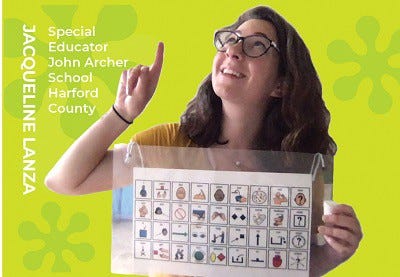
Jacqueline Lanza, Harford County
Because I teach kids with severe and profound needs, hands-on learning experiences are crucial for them.
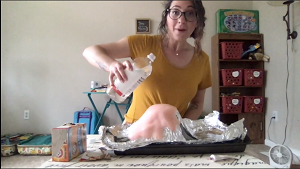
I incorporated one of our Core Vocabulary words — “out” — into this lesson on volcanoes so that it hits a few different types of learning that we focus on: science, sensory, and communication. In the video, I model the core vocabulary word, highlight the picture symbol, sign the word using ASL, and then create a volcano for “lava” to come OUT of! It’s a very fun and simple activity that families can easily bring to life at home. I love the educational component of it, as well as the sensory piece that would usually be there … but instead of smelling the vinegar (one of the key ingredients to creating the “lava”) themselves, I’m hoping some of my students will get a kick out of watching ME smell it instead, and maybe cringe with me.
I am hoping that somehow, even during this unprecedented time when I can’t be next to them, holding the fizzing volcano up to their ears, I can still reach them in an engaging and educational manner.

